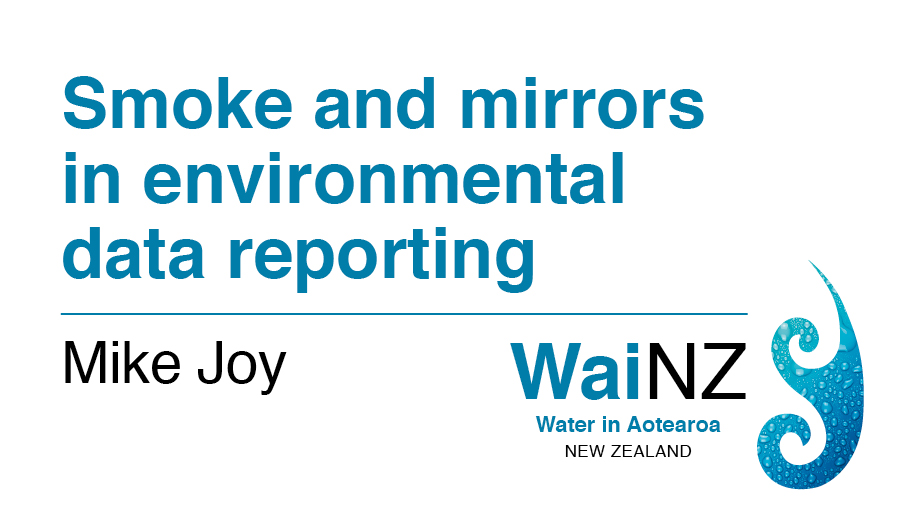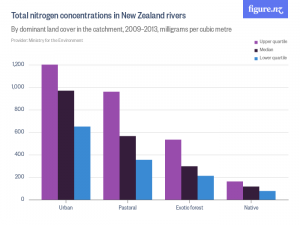The misuse of scientific data to portray a particular perspective is not unusual in advertising, but the presentation of water quality data by the government in New Zealand is a glaring example of misrepresentation to alter public perception.
Here is one example: figure.nz graphs from the Ministry for the Environment website give average values for a range of water quality parameters. They are presented in the ‘four major land cover classes’: urban, pastoral, native and exotic forest, based on the dominant land cover in the catchment of the site.1
The graphic above clearly shows that for nitrogen – and the other water-quality parameters show a similar pattern – the worst water quality is in urban catchments; the next worse is pasture, then exotic and the best sites are in native forest.
Looking at the graph above, it’s blatantly obvious that Federated Farmers and other industry commentators are right; urban dwellers are our water-quality problem, as urban sites are plainly worse than all the over land cover classes and clearly worse than farming (pastoral).
Unfortunately, that conclusion is almost completely incorrect because what the graphs don’t reveal is that urban waterways make-up less than 1% of the total length of waterways in New Zealand. In contrast, pasture is close to 40% of river length. And because most urban waterways are small, the volumes of pollutants are orders of magnitude less in urban waterways compared to pastoral.
So, while it is a fact that urban sites are on average worse than pastoral sites, there is a big ‘but’ here: urban sites are a minuscule proportion of the length of waterways of New Zealand. This is not to say that we should ignore the urban sites – all waterways need to be protected – but clearly, we should prioritise the biggest problem first.
To correct the misrepresentation in the graph above, the widths of the bars should be made proportional to the total length of waterways in New Zealand they represent. At 0.8% of the total length of waterways in New Zealand, the bars for urban land cover would be so slim they wouldn’t be visible without a magnifying glass.
This anomaly I have highlighted here is very well concealed. Almost every report on the Ministry for the Environment website, and most of the background reports done by NIWA, do not point this crucial detail out. The only paper I could find that does mention it is a 2004 peer reviewed journal article2 and this paper concentrated on lowland rivers and thus reported the proportions of total length in lowland rivers. Despite the fact that nearly all our urban catchments are in lowlands, urban waterways are still only 1.6% of the total lowland waterway length, followed by exotic forest at 6%. Native forest is 18% and pasture is 74%.
This example of a graphical misrepresentation highlights the need for some independent oversight of the data presented by government departments, in this case, the Ministry for the Environment and Statistics New Zealand. It emphasises the need to keep crucial environmental data collection and reporting with an independent body well away from government departments.
These water-quality graphics are a not so subtle but effective way of downplaying the impact of farming on water quality and sadly is just one of many. The sad thing is that it just adds to the confusion and means that farmers don’t get to see the truth and see this misrepresentation of data and rightly feel hard done-by. Even worse, the downplaying of the real problems reduces the chances of anything being done to address them.
Mike Joy
References
- Statistics New Zealand. River water quality: nitrogen. URL: http://www.stats.govt.nz/browse_for_stats/environment/environmental-reporting-series/environmental-indicators/Home/Fresh%20water/river-water-quality-nitrogen.aspx
- Larned, S.T., Scarsbrook, M.R., Snelder, T.H., and Biggs, B.F. (2004). Water Quality on Low-elevation streams and rivers of New Zealand recent state and trends in contrasting land cover classes. New Zealand Journal of Marine and Freshwater Research 38, 347-366.
About:
Mike Joy is a Senior Lecturer in Ecology and Environmental Science at Massey University. He researches and teaches freshwater ecology, especially freshwater fish ecology and distribution, ecological modelling bioassessment and environmental science. His book, ‘Polluted inheritance: New Zealand’s freshwater crisis’ was published by BWB Texts in November 2015.
What is WaiNZ?
Kia ora, Aotearoa. We’ve asked leading environmental, social and health researchers to share their personal and professional perspectives about the state of our water and what water means to us as New Zealanders. Follow their blogs right here at tepunhahamatatini.ac.nz and across social media with #WaiNZ.
Where possible, commentary will be backed up by data from Figure.NZ. Their incredible charts are based on data sourced from public repositories, government departments, academics and corporations. Check out their #WaiNZ data board and sign-up to create your very own data board on any topic that interests you.


